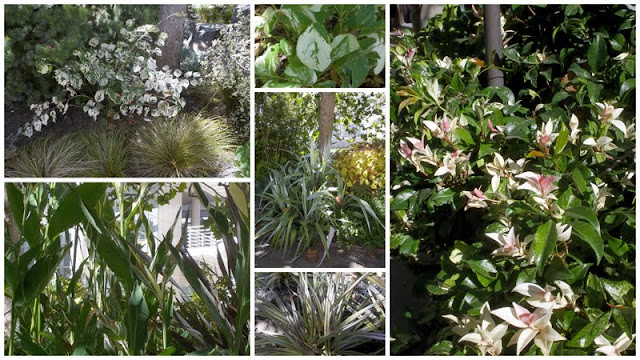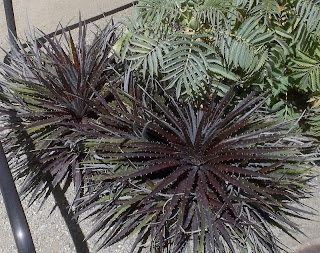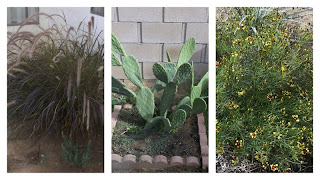I thought I was going to miss this month's Foliage Follow Up (hosted by
Pam at Digging - go there to see more!), because I haven't had a chance to take any pictures out in the garden, and I had to travel again. But I realized that almost all the pictures I took during my latest visit to
The Getty were of foliage plants, so I'll use that for this month's post!
First, a little bit of history that I learned during the guided Garden Tour at the Getty: while the main
museum was designed by
Richard Meier, who is renowned for his use of grids and ordered patterns in architecture, the Central Garden was designed by
Robert Irwin, who is an artist, not a gardener/landscape architect. Of course, the two aren't necessarily an either/or, but Irwin was going for an "art experience" in a garden, and not necessarily selecting plants for water use, climate adaptability or other "practical" elements, but rather the experience they provided the visitor. His motto for the Central Garden is "Always changing, never twice the same", which I think is true of any garden!
The lower part of the central garden is a full sun site, and here is where a lot of flowering plants are:
 |
| All these plants (and more) are in the lower central part of the garden. I love the giant Angel's Trumpet tree |
The main colors are yellow, orange and red, with splashes of purple, a pretty "hot" color palette, but appropriate for the "hot" summer. Apparently, the garden staff (5 permanent, with 7 extras during the summer season) switches plants out during the seasons. And while the flowers definitely demand a lot of your attention, there's also so pretty cool foliage, like this spiky orange plant:
 |
| Even though it's not labeled, this is a Solanum pyracanthum or “Porcupine Tomato” And I want one |
One thing that's always driven the engineer in me nuts is that none of the plants are labeled! So I had to look up the name of this cool spiky plant when I got home... But that's on purpose - Irwin didn't want this to be a botanical garden, but rather an "art installation". That's part of the reason I'm not using the full botanical names of most of the plants in this post, to honor that spirit. But good thing there aren't too many plants with orange spiky leaves! I want one for next year.
One rather unique feature of the garden is a pungent onion/garlic smell, coming from the ring of variegated Society Garlic ringing the entire bottom end of the garden:
 |
| It really smells - you can even smell it over the Crape Myrtles |
I learned that it was supposed to keep the deer out, but it didn't work! Until the Getty installed a deer fence, they used to have employees in the garden at night to chase away the deer. Where do I sign up for that? A whole night in the garden would be amazing...
Walking out of the bottom part of the garden, there are several containers, filled with different plants. These two struck me as funny - and the importance of keeping in mind the final size of your plant relative to the container:
 |
| The giant grass in the tiny container is funny. |
The next part of the garden is the "central ravine", which includes a water feature that looks like a stream, and is mostly dappled shade. And a very specific dappled shade - the garden staff removes every other leaf from the shade trees (London Beech Trees, I think?) every month during the summer! That is insane!
In one of the sunny spots, I saw a combination I would love to re-create at home:
 |
| I have that grass (it's orange sedge)! I can just add some darker foliage plants around it... |
And the color of this New Zealand Flax is beautiful, and goes on my "Front Garden Re-Vamp Inspiration" board:
 |
| Beautiful! I wonder if it would keep this color in full sun? |
The garden path zig-zags up the slope, bringing in and out of the shade, and closer and further away from the water. According to our tour guide, this was done to avoid the garden equivalent of "art fatigue". In the shade, there are so many different variegated plants!
 |
| Variegated plants throughout the garden - the way the light plays off them is very pretty |
The picture on the bottom left is a variegated Canna, I think. There were also pops of red and yellow in this part of the garden, but a lot less than in the sunny part.
On either side of the "ravine", there are big expanses of lawn, edged by deer grass, carex, and (new) Liriope, blooming with purple flowers. These plants curve with the grass to form the edge of the garden:
 |
| I'm not sure the Liriope adds much, but keeping visitors safe is important... |
The Liriope is a new addition, added to keep small children from jumping from the grass onto the pathways. The Getty encourages people to sit on the grass for picnics, to relax, or to take in the view. Our tour guide claimed that the garden staff consulted Robert Irwin on what to add as a "barrier plant". Considering that he designed the garden back in 1997, that is a very long time to stay involved in the project!
Near the top of the garden was this pretty collection of Dyckia:
 |
| Gorgeous! I assume the color was picked on purpose... everything coordinates in this garden |
I wish mine looked this good! They even tie into the color of the railings... excellent foliage color!
This plant choice made me smile:
 |
| The upper-most beds, near where the water feature starts, are filled with succulents. One of the few areas in central garden that uses them, really. |
An agave next to a running stream :). That's not something that you see in nature very often!
Now, from the top of the garden, looking back down, you can see a very interesting feature - the big trellises covered with different colors of Bougainvillea:
 |
| So cool! I'm not sure I've ever seen bigger Bougainvillea plants. |
There are actually six of them - three on each side. They provide welcome shade, and look really cool too.
I'm going to end this post with a collage of many of the container plantings throughout the Getty, mostly in the museum area:
 |
| Most of these container are actually throughout the museum, tucked away like little treasures |
All of them are based on foliage - mostly succulents. Some of these were my inspirations for some of my own plants, and some will work their way into my front garden re-vamp, maybe! Like that Cordyline (bottom left) and New Zealand Flax (upper right).
There is a whole other aspect to the gardens at the Getty - the part that was designed by the architect, Richard Meier. It includes the cactus garden, and a lot of the planting across the museum grounds. They're very different - much more zen and orderly, as opposed to the lush fullness of the Central Garden. I'll do a follow up post with those pictures! For now, I hope you enjoyed this walk through the Central Garden. If you ever find yourself in LA, I'd highly suggest a visit.
Oh, and
the museum has some art too :) I'm told that's why the building and gardens were built - but really, I think they got that backwards!











